Plant Focus: Allium
Bringing bold colour and structure to landscapes
Allium is a genus of over 700 species from the Amaryllidaceae family of plants, ranging from ornamental varieties that boast architectural form and vibrant, globe-like flowerheads, to edible varieties, including garlic, leeks, and onions. It’s a diverse genus, with species that vary in shape, size, and colour. Allium giganteum, for example, can reach impressive heights and produce giant spherical flowers that create a dramatic focal point, whilst others, like Allium flavum, are more compact and produce small, bell-shaped, bright yellow flowers.
Many Allium varieties have clusters of star-shaped flowers that form their striking globe shape, in a range of colours, including purple, pink, white, yellow, and blue. Usually, Allium provides a long-lasting flower display from May to June, and it helps to bridge the gap between spring and summer. Its foliage tends to be strappy, and appears around a month before flowering. With some species, this means the foliage can fade before it has finished flowering. To keep them looking their best, alliums can be planted as a focal point in the middle of borders, amongst ornamental grasses, for example, to disguise any faded foliage.
Ornamental alliums are some of the most striking and versatile plants you can grow. Their unique shape and geometric appearance have made them a garden favourite for centuries. They grow from a bulb, and prefer a sunny and sheltered position. They are well suited to Mediterranean planting schemes, as well as prairie-style planting and cottage gardens. Alliums look most impressive when planted en masse in flower borders and beds, and some species, such as Allium karataviense ‘Red Giant’, work well in gravel gardens and containers.
Key Characteristics:
✓ Bulbous perennial
✓ Globe-like flowerheads
✓ Strappy foliage
✓ Height varies from 25cm to 1.2m
✓ Thrives in sheltered, sunny spots
✓ Low maintenance
✓ Ideal for planting in borders and containers
✓ Usually flowers from May to June
✓ Good for pollinators
Did you know?
Alliums naturally produce sulphur compounds, which are the same chemicals that give garlic and onions their strong taste and smell. These sulphur compounds are unappealing or toxic to many pests, such as aphids and slugs, and gardeners often plant alliums near other vulnerable crops, providing an element of protection.
Our recommended Allium species

Allium cristophii
Allium cristophii
Allium cristophii is known for its star-shaped purple blooms. It produces large, globe-like flowerheads to 20cm in width from June to July, and grows up to around 60cm in height. It’s ideal for adding vertical interest to borders and works well in a Mediterranean planting scheme.
Allium giganteum
A striking bulbous perennial that is prized for its tall, architectural presence. Produces large, dense globes of small, star-shaped purple flowers to 20cm across, on sturdy, upright stems. Allium giganteum is a great species for planting in groups in sunny borders.
Allium ‘Globemaster’
One of the most popular varieties, Allium ‘Globemaster’ has large, showy purple blooms to 20cm in width. It is ideal for adding interest to sunny flower borders, and also works well in containers. Grows to around 80cm in height.
Allium ‘Ambassador’
Allium ‘Ambassador’ is a newer Allium variety with large, spherical heads of deep purple blooms. It grows up to around 1.2m in height, and looks great as part of a cottage garden in sunny borders and beds.
Allium karataviense ‘Red Giant’
A bulbous perennial with large, spherical purple-red flowers to 8cm across, and red-margined, purple-tinged broad leaves. It’s one of the smaller varieties that grows up to 25cm in height. Works well for positioning in the front of borders, growing in containers, or gravel gardens.
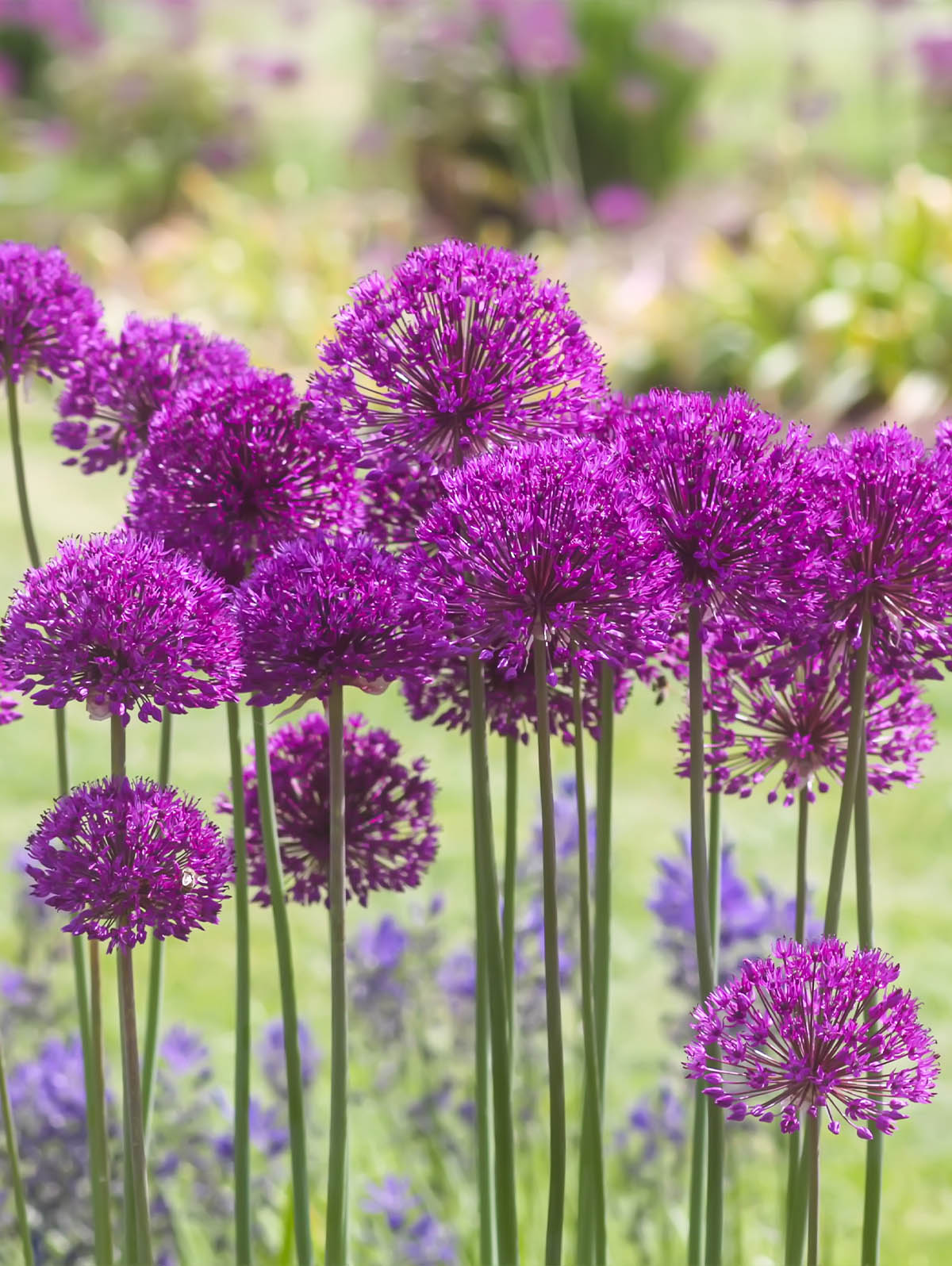
Allium giganteum
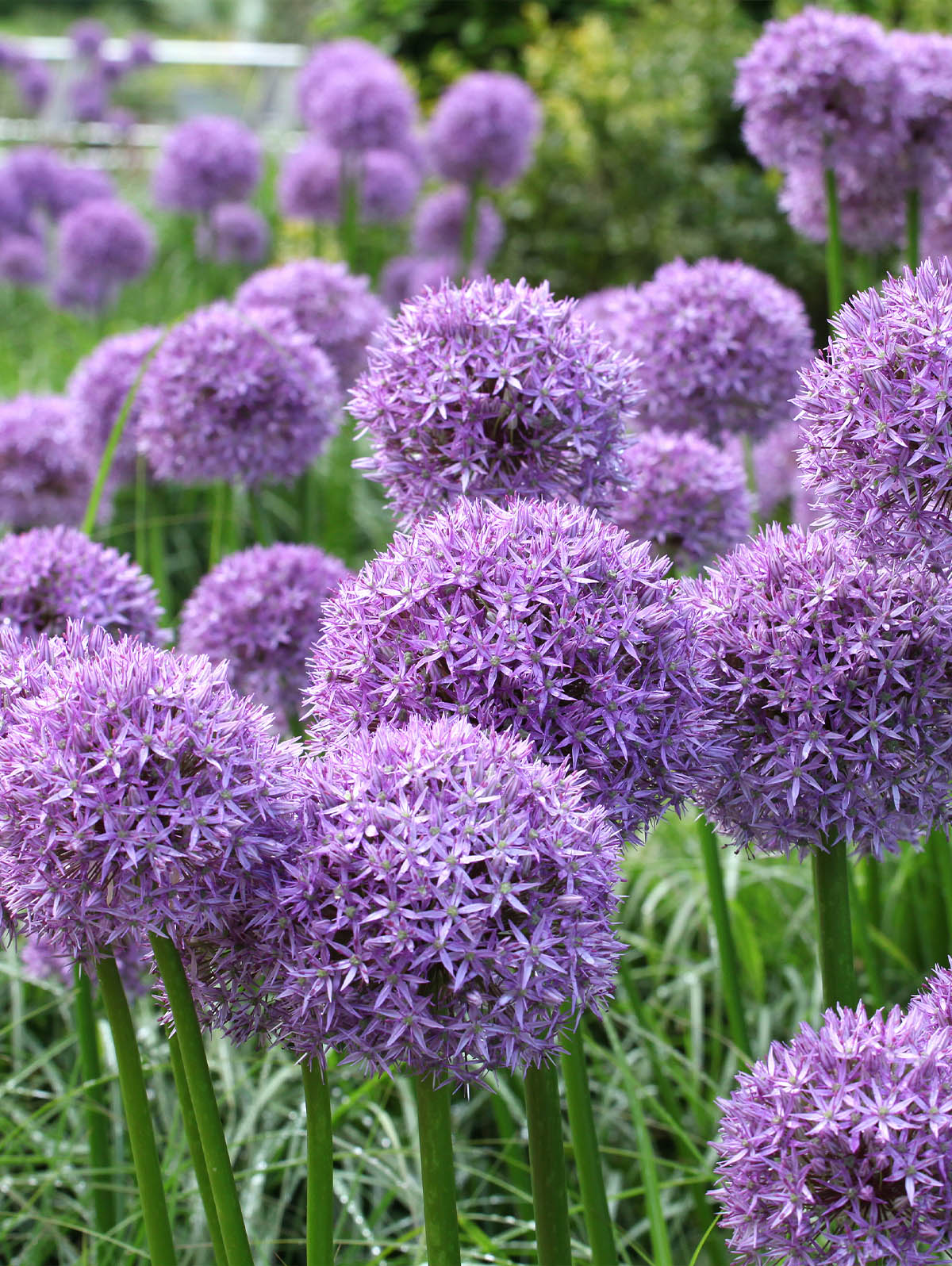
Allium ‘Globemaster’
Allium amethystinum ‘Red Mohican’
An eye-catching allium that has maroon-red flowers with tufts at the top, which are tipped with very small white flowers. Grows to around 1m in height and combines well with ornamental grasses.
Allium flavum
A distinctive allium with clumps of narrow blue leaves and bright yellow, bell-shaped flowers on slender stems. Growing to around 40cm in height, Allium flavum is ideal for gravel gardens and containers.
Allium ursinum
A UK native, Allium ursinum is a vigorous bulbous perennial with a distinctive, garlicky scent. It has erect stems that bear white spring flowers, and aromatic elliptic leaves. Commonly known as wild garlic, Allium ursinum is a great source of early nectar for pollinators, and is ideal for planting in wildlife gardens.
Allium sphaerocephalon
Allium sphaerocephalon is an allium with egg-shaped, green flowerheads, which mature to maroon-red over time. It flowers from July to August, which is later than most Allium species. Ideal for combining with ornamental grasses in sunny herbaceous borders. A UK native and grows up to around 90cm in height.
Allium azureum
An allium with stunning globes of bright blue flowers on stiff stems and mid-green narrow foliage. Grows up to around 60cm in height and works well in a sunny border alongside other medium-sized herbaceous plants, which will help to disguise its faded foliage.
Allium moly
A bright yellow allium with green stems and swords of strap-shaped, grey-green leaves. Allium moly grows to around 25cm in height and is ideal for growing in containers and gravel gardens.
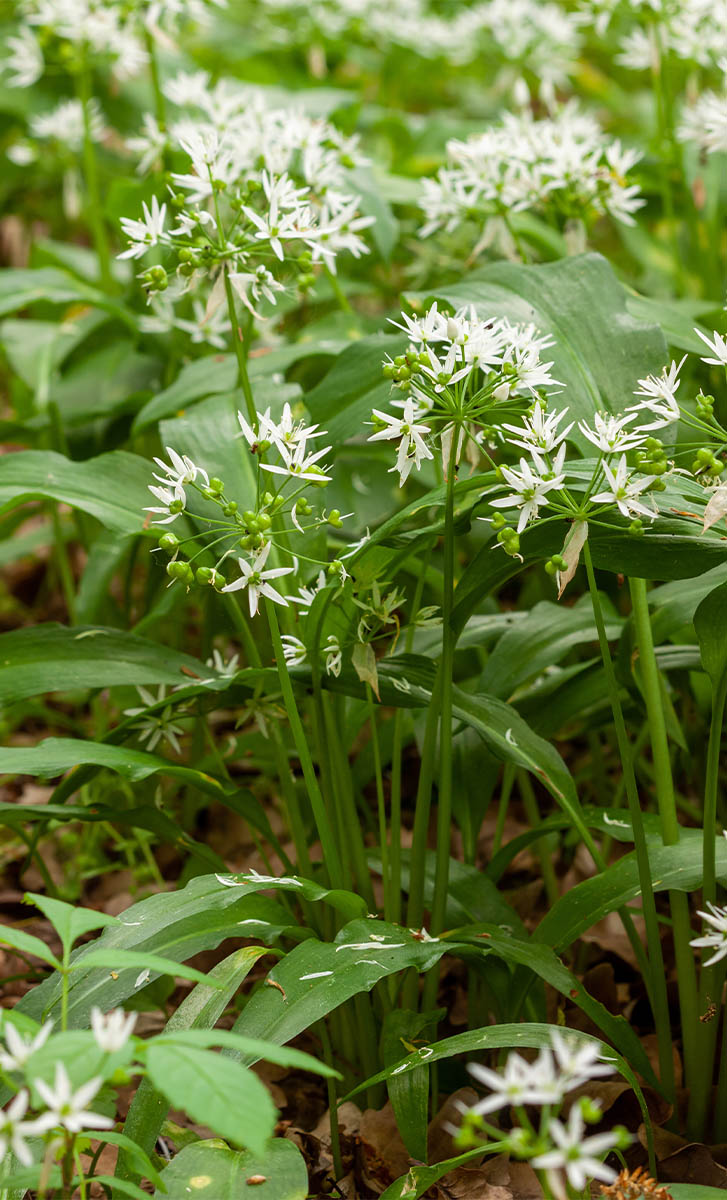
Allium ursinum

Allium sphaerocephalon
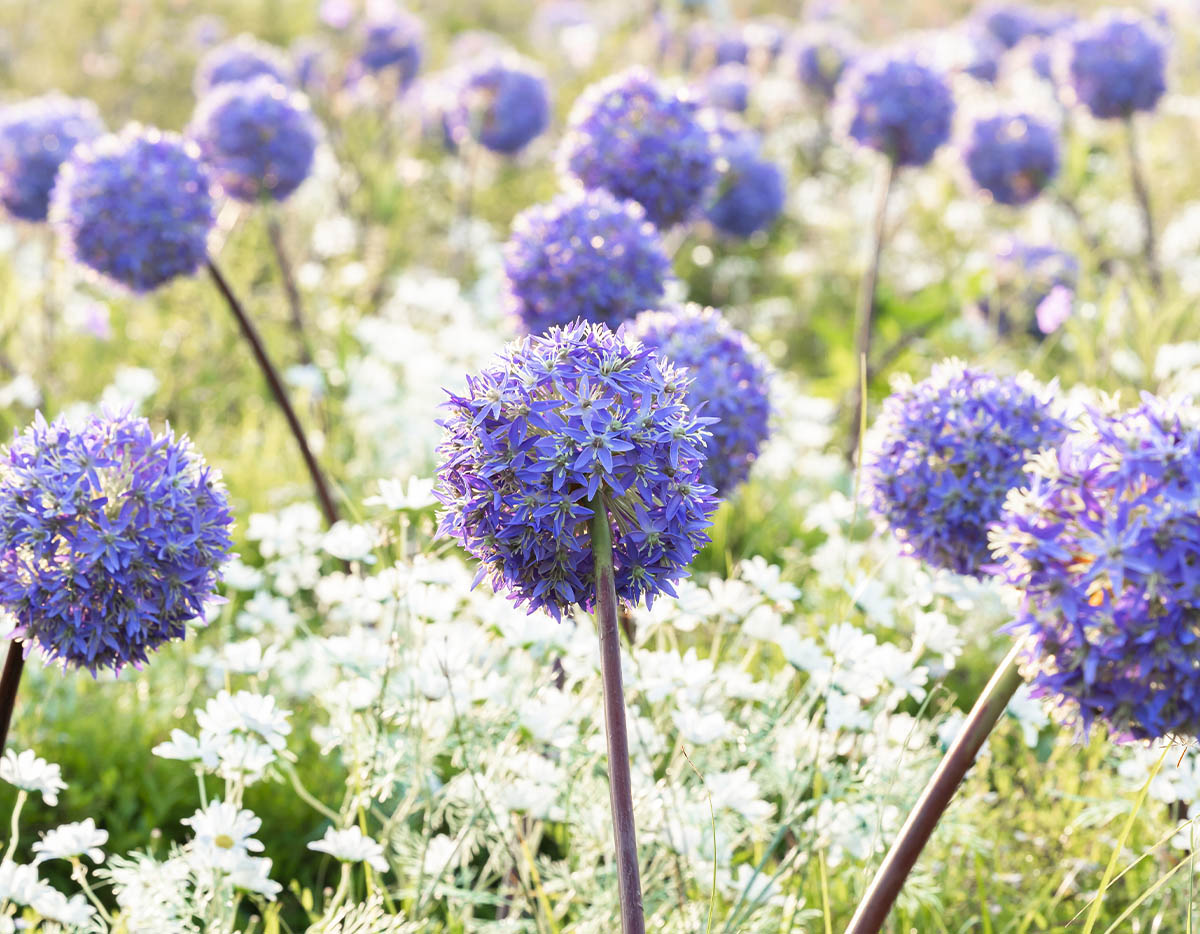
Allium azureum
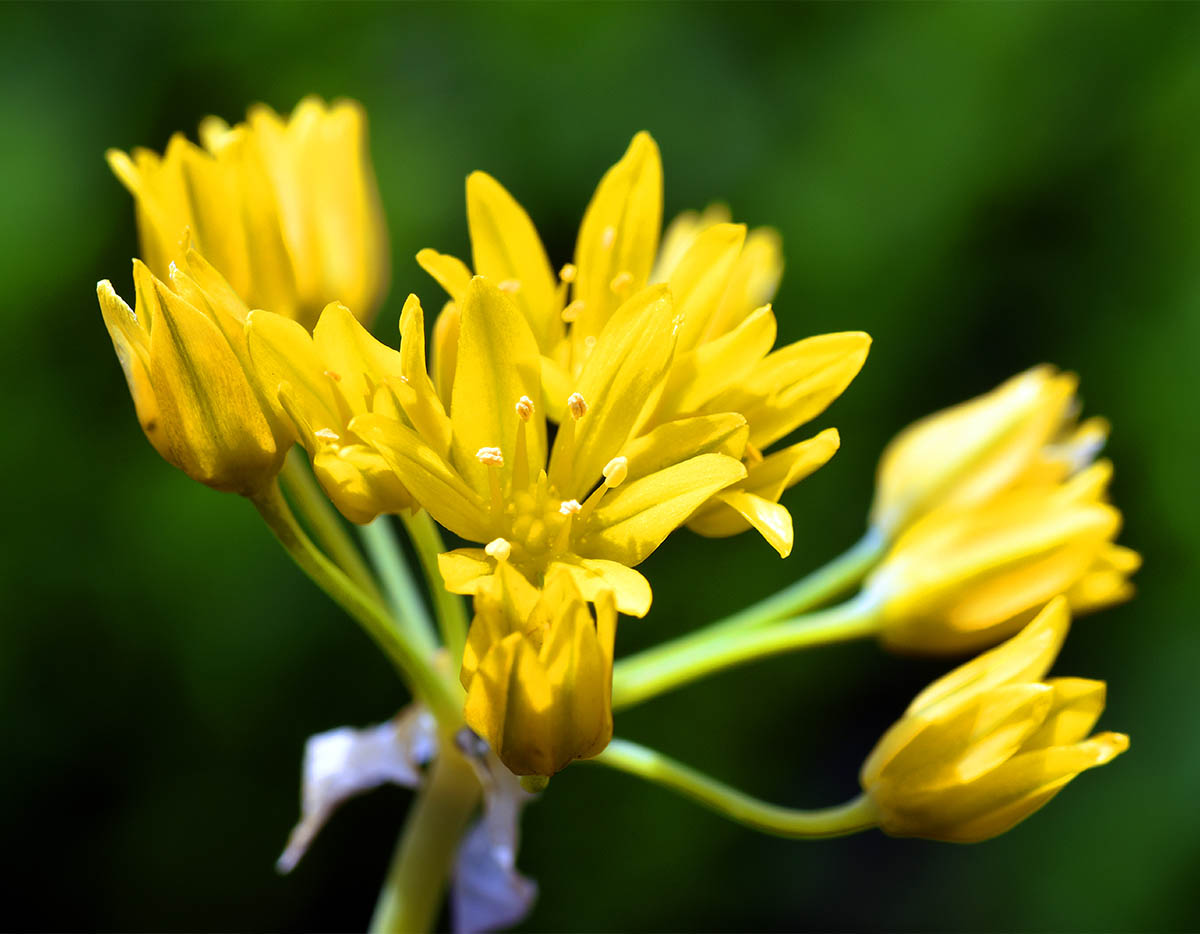
Allium moly
How to grow and care for Allium
Allium is a bulbous perennial that can live for up to four years after being planted. It’s generally known for being a low maintenance plant, especially if it’s grown in the ground.
The best time of year for planting Allium is September to November, as it allows the bulbs enough time to establish strong root systems before the soil freezes in winter. Allium should be planted at a depth that is around four times the size of the bulb. Compact species should be planted three to four inches apart, whilst tall species need around 20cm between each bulb.
For Allium to thrive, it should be planted in a sheltered, sunny position, in moist, well-drained soil. Taller varieties in particular will benefit from a sheltered spot, to protect them from blowing over in the wind. Avoid planting Allium in areas that are cultivated often, as the bulbs can get damaged during this process.
Alliums grown in a container require regular irrigation, whereas alliums grown in the ground are more drought tolerant. Fertiliser can be added in spring, when new growth appears.
Foliage can be pruned after it has turned yellow and started to dry out. This will allow the bulb to store its energy for the following year. Faded flowerheads can be left on the stems to provide interest through autumn and winter.
Pests and diseases that can affect Allium
Allium leaf miner
Allium leaf miner is a pest that results in holes and distorted leaves as it tunnels through them. Flowerheads can also be damaged. To prevent further harm to the plant, infected leaves and debris should be removed.
Aphids
These are small, sap-sucking insects that can cause leaves to curl and turn yellow. Aphids can usually be controlled and eliminated by natural predators. If this is not successful, then biological products can be used for treatment.
Thrips
Thrips are tiny, sap-sucking insects that leave silver streaks on the leaves of alliums. Pruning any infected plants, as well as encouraging natural predators, can help to control populations of thrips.
Onion fly
Onion fly larvae feed on plant roots and cause yellowing of leaves, as well as stunted growth. Rotating crops and planting in well-drained soil can reduce the risk of onion fly. Beneficial nematodes can be introduced to prevent any further infestations.
Downy mildew
Downy mildew is caused by a fungus, and it disfigures the plant’s aesthetic appearance by causing withering and discolouration, potentially leading to rotting and death. If it’s spotted early, leaves can be removed. Unfortunately, if it has totally taken hold, the whole plant must be carefully disposed of.
Allium root rot
Otherwise known as onion white rot, allium root rot is a serious fungal diseases that leads to wilting, yellowed foliage and decay of the bulb and roots. Unfortunately, once it has been introduced, it’s impossible to eliminate. It’s important to follow good hygiene practices to avoid spreading to unaffected areas.
If you would like more information on the Allium species and varieties we sell, get in touch with the G Team.

